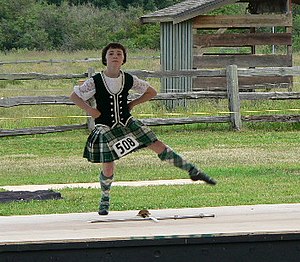Highland dancing: Difference between revisions
Jump to navigation
Jump to search
imported>James F. Perry (create article (intro section)) |
imported>James F. Perry (add image) |
||
| Line 1: | Line 1: | ||
[[Image:05_Bel_002.jpg|thumb|right|300px|A young Highland dancer demonstrates her form in the sword dance at the 2005 Bellingham (Washington) Highland Games]] | |||
'''Highland dancing''' is the national dance of [[Scotland]]. It is an integral part of nearly every [[Highland games]] event where, in its most common public | '''Highland dancing''' is the national dance of [[Scotland]]. It is an integral part of nearly every [[Highland games]] event where, in its most common public | ||
face, the dancers can be seen competing in traditional dances wearing colorful [[Kilt|Highland attire]] and accompanied by [[Great Highland Bagpipe|bagpipe]] music. It is in the context of these competitions that Highland dancing evolved over the years into its present form. | face, the dancers can be seen competing in traditional dances wearing colorful [[Kilt|Highland attire]] and accompanied by [[Great Highland Bagpipe|bagpipe]] music. It is in the context of these competitions that Highland dancing evolved over the years into its present form. | ||
However, neither competition, nor Highland attire, nor bagpipe [[music]] is a necessary part of Highland dancing. Sometimes the dance form can be seen in exhibitions (or danced for pleasure) with the dancers wearing uniquely designed costumes and dancing a choreographed routine to theme music of their choosing. | However, neither competition, nor Highland attire, nor bagpipe [[music]] is a necessary part of Highland dancing. Sometimes the dance form can be seen in exhibitions (or danced for pleasure) with the dancers wearing uniquely designed costumes and dancing a choreographed routine to theme music of their choosing. | ||
Revision as of 19:04, 24 June 2007
Highland dancing is the national dance of Scotland. It is an integral part of nearly every Highland games event where, in its most common public face, the dancers can be seen competing in traditional dances wearing colorful Highland attire and accompanied by bagpipe music. It is in the context of these competitions that Highland dancing evolved over the years into its present form.
However, neither competition, nor Highland attire, nor bagpipe music is a necessary part of Highland dancing. Sometimes the dance form can be seen in exhibitions (or danced for pleasure) with the dancers wearing uniquely designed costumes and dancing a choreographed routine to theme music of their choosing.
